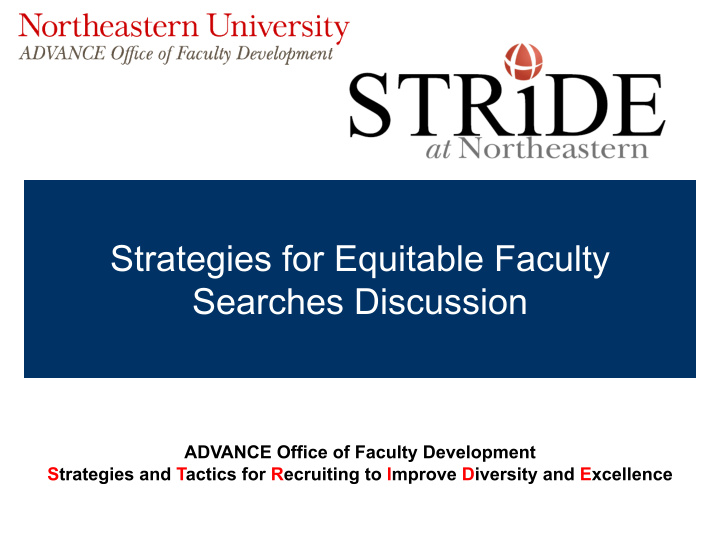



Strategies for Equitable Faculty Searches Discussion ADVANCE Office of Faculty Development Strategies and Tactics for Recruiting to Improve Diversity and Excellence
Introductions 2
STRIDE Committee Members Jackie Isaacs , Professor of Mechanical and Industrial Engineering, Chair Dan Danielsen, Professor of Law Jack Dennerlein, Professor of Physical Therapy Judith Hall, University Distinguished Professor of Psychology Marjorie Platt, Professor of Accounting Kathrin Zippel, Professor of Sociology Jan Rinehart, Executive Director ADVANCE Office of Faculty Development Erinn Taylor de Barroso, Assistant Director ADVANCE Office of Faculty Development Previous STRIDE members: George Adams , Mechanical & Industrial Engr.; Dana Brooks , Electrical & Computer Engr.; Agnes Chan , Computer and Information Sciences; Barry Chung , Counseling and Applied Educational Psychology; Max Diem , Chemistry and Chemical Biology; Luis Falcon , Sociology and Anthropology; Craig Ferris , Professor Psychology; Miriam Leeser, Professor Electrical and Computer Engineering; Ineke Marshall , Sociology and Anthropology, Criminal Justice; Ramiro Martinez, Professor Criminology and Criminal Justice; Carla Mattos, Professor of Chemistry and Chemical Biology; Sanjeev Mukerjee , Chemistry and Chemical Biology; Rajmohan Rajaraman, Professor Computer and Information Sciences ; Mark Williams, Professor of Physics; 3
Academic Values • Search for truth • Freedom to explore ideas • Respect for knowledge and expertise • Valuing of creativity and innovation • Commitment to meritocracy • Willingness to open doors to all groups in society 4
Implicit Associations Implicit bias • implicit social cognition or association • refers to the attitudes or stereotypes that affect our understanding, actions, and decisions in an unconscious manner. 5
STRIDE Workshop Goals Participants will discuss and learn from each other… • How to improve the search process • Strategies to avoid implicit bias • Good practices for search committees 6
Agenda • Introduction • Discussion I: Hearing existing good practices • Discussion II: Discussion of Ed Yong’s Article • Discussion III: Next steps • Closing • Evaluation 7
Gender and Diversity • Gender intersects with race & ethnicity, class, LGB/TQ+, age, disability, religion etc. • For example, how is the recruitment similar or different for white women and faculty of color? 10
Discussion I: Using Good Practices • Write down 1-3 ideas that worked well in search committees you have worked on in the past • Share with a partner at your table – 3 minutes each • Share 1 idea you liked • Place each post-it note on one of the large papers by stage of the faculty search 11
Five Stages of a Faculty Search A. Define criteria and qualities B. Actively recruit a diverse pool C. Review and identify the long/short list D. Conduct an effective on campus interview E. Recommend finalist(s) to Chair 12
Reflection What struck you as you read, “I spent Two Years Trying to Fix the Gender Imbalance” by Ed Yong? 13
Discussion II: Article by Ed Yong “I Spent Two Years Trying to Fix the Gender Imbalance in My Stories” • What was the article about? – How to tackle gendered imbalances in his reporting – How to identify/find experts – Documentation of his journey trying to avoid bias 14
The Revelation • Major imbalance in women and men experts chosen for interviews • Objective assessment of skill or easy to reach? – Known names – Top a Google search – Others have spoken to/quoted them – Accrued reputation • Change requires work! – Contacted 1.3 men vs 1.6 women 15
Strategies Yong Used • Tracked what he did via spreadsheet => DATA • Went beyond usual strategies/short cuts to select experts • Broadened his search – Contacted several sources – Built diverse list of experts – Thinking about how to expand changes further 16
Judging “Most Qualified” • Using shortcuts – Calling on same experts over and over – Relying on experts other reporters have ”vetted” • Academic Parallel? • Highlighting new voices – Journalism thrives by seeking fresh perspectives/voices – Avoiding the same small cadre of well-trod names • Academic Parallel? 17
Discussion II: Good Ideas from Ed Yong • Table discussion questions – How would you apply the strategies used by the reporter to a faculty search? – How would you describe this strategy to your search committee members? 18
Judging ”Most Qualified” in Academia • Relying on proxies in assessing quality – Prestige of institution – Numbers of publications – Prestige of publications and impact factors – Letters of recommendation • Consider your definition of excellence – Example: Northeastern’s inclusion of contributions to diversity in T&P dossier • Find those women and minority men who would likely succeed 19
Discussion III: Next Steps • Write down 1-3 ideas you plan to take back to your search committee – 1 per post-it note • Discuss at your table what everyone wrote down • Share with the group • Put your post-it notes on the large sheet of paper 20
Five Stages of a Faculty Search A. Define criteria and qualities B. Actively recruit a diverse pool C. Review and identify the long/short list D. Conduct an effective on campus interview E. Recommend finalist(s) to Chair 21
Summary • Search Actively and Broadly • Advocate • Speak up for equity • Go the extra mile • Be intentional 22
Thank you 23
Recommend
More recommend